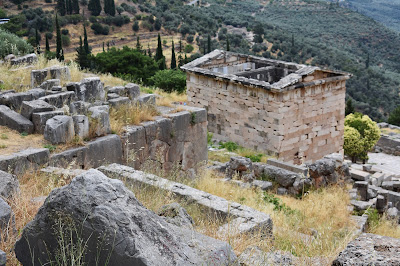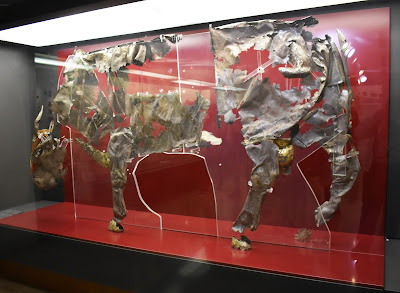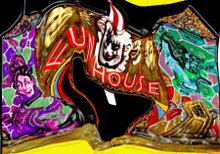Delphi
So as the clouds rolled in we arrived at Delphi. Delphi is where the ancients went when they needed help and wanted ot know what the future held in store for them.
We passed the source of the spring in the bus...
and then were let off at the foot of Mount Parnassus, the home of the Oracle. On the way we saw several spiders.
Once again there were walls with that typical stick and stone construction. Perhaps these are some of the treasury buildings.
As one walks along the Via Sacra (or sacred way) one passes the sites of a variety of treasure houses. We turned to the right and could see the beginnings of the stoa with the temple of Apollo a bit higher on the hill.
After one passes the council house one sees the location of the niches where the altars were. In one of these (or perhaps behind one) was located the tripod of Platae where the Oracle would divine the future.
The oracle was a sibyl, a pure, but older woman who would breathe in the
pneuma or vapors over a chasm and then in a state of trance make pronouncements. The Delphi oracle was called a Pythia because she derived her power from the vapors arising from the corpse of Python, a large snake killed by Apollo.
These would be written down by priests in hexameter. There is much debate over what intoxicated the ibyls. Some say she chewed laurel (which is also translatable as oleander which is a poisonous plant which could well cause hallucinations.) Others think the ehtylene in the pneuma could have been responsible, while still others suggest it could have been cannabis or even rhodendron that the sibyls chewed to enhance their visions.
Here is a little wild geranium or cranesbill htat was blooming on the site.
There was somewthing rather romantic about these two tourists.
Here is a site map of Delphi.
Below is the Athenian treasury commemorating their victory at Marathon.
Here you see some of the remaining columns of the temple of Apollo.
Evidently Apollo only stayed around in the winter months and supposedly Dionysus showed up in t the summer, so divination was not done at these times.
This could be a part of the palastra.
A better shot of the columns of the Temple of Apollo.
Here is a view of the footprint of the Temple of Apollo.
A little higher up is a theater. This was first built in 4th Century BC/E but was remodelled for Nero around 67AD
Even higher up was a stadium (where they ran races), but I decided to go to the museum instead of the stadium.
The museum was very nice and had quite a lot of interesting artifacts, especially those from the archaic period.
These bronze figures are from the 8th century BC/E and were probably offerings to the gods.
These bronze helmets stem from 7th and 6th centuries and are of the Corinthian style.
These kouroi are archaic Pelopennesian pieces from around 580 BC/E. They are labelled Cleobis and Biton, although this is disputed and some think they represent the twin sons of Zeus, the Dioscuri or others perhaps a verson of Castor and Pollux. They are labelled ϜΑΝΑΚΩΝ which means princes.
I really liked this lion figure.
This is a representation of the Calydonian boar that was sent by Artemis to lay waste to Calydon and was humted by fierce heroes in a mythological hunt.
This was thin hammered metal (probably silver?) made in the form of a bull.
And here we have gold jewelry and ornament.
Finally an impressive figure of a charioteer.
All too quickly it was time to get back on the bus again and head towards our next hotel in Kalambaka.
On our way we saw this interesting water reservoir.
The lobby was gigantic.

Here was our dinner
On our way we saw this interesting water reservoir.
The hotel was really big with wide spacious corridors. This was the view out the window.
The lobby was gigantic.
Our room was homey and comfortable.

Here was our dinner

















































No comments:
Post a Comment